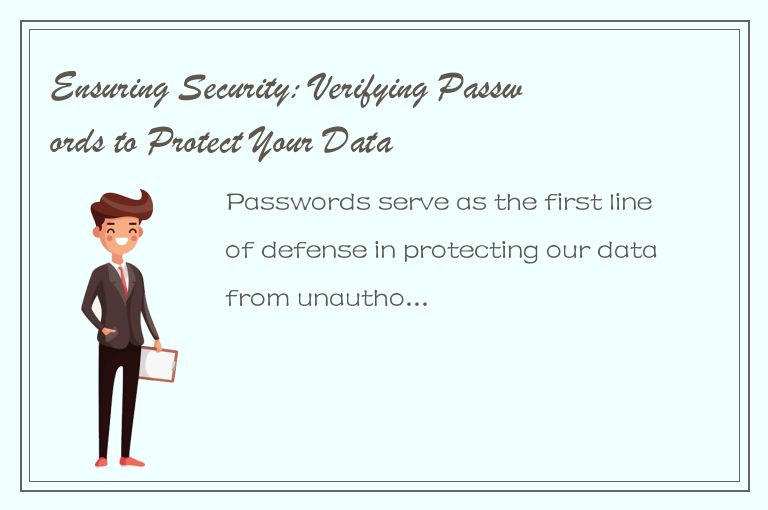Passwords serve as the first line of defense in protecting our data from unauthorized access. They are the key to accessing our online accounts and sensitive information, from bank accounts and social media profiles to email and cloud-based storage platforms. However, as the world becomes more digitized, our reliance on passwords has increased and so has our vulnerability to cyber threats. In recent years, the number of data breaches and cyber attacks has significantly increased, highlighting the need for stronger password protection. Therefore, verifying passwords has become more important than ever to ensure data security.

One of the most common methods of password verification is the use of hashing algorithms. Hashing is a process of converting plain text passwords into unreadable strings of characters, known as hashes. When a user sets a password, it is stored as a hash instead of the actual password. When a user logs in, the entered password is hashed, and the system compares the hash with the stored hash. If the hashes match, the system grants access, and if they don't, it denies access. This process ensures that user passwords are not stored in clear text form, which can be easily accessed by hackers.
However, not all hashing algorithms are equally secure. The most commonly used hashing algorithms, MD5 and SHA-1, are known to be vulnerable to brute-force attacks. Brute-force attacks involve trying out all possible combinations of characters until the correct password is found. Since MD5 and SHA-1 hashes are relatively short, they are quickly reversed by modern computing power, making them vulnerable to password cracking. Therefore, it is recommended to use stronger hashing algorithms, such as SHA-256, SHA-384, or SHA-512, which generate longer and more secure hashes.
Another method of password verification is the use of two-factor authentication (2FA). 2FA adds an additional layer of security to the login process by requiring users to provide two forms of identification, such as a password and a code sent to their mobile device. This ensures that even if an attacker manages to guess or steal a password, they cannot gain access without the second factor. The use of 2FA significantly reduces the risk of account takeover, and it is recommended to enable this feature wherever possible.
Furthermore, users must also follow best practices when creating passwords to ensure their security. Passwords should be long and complex, consisting of a combination of uppercase and lowercase letters, numbers, and symbols. They should not be predictable, such as using common words, dates, or personal information. Furthermore, users should avoid using the same password for multiple accounts, as this increases the risk of credential stuffing attacks, where attackers use a combination of usernames and passwords from previous breaches to gain access to other accounts.
In conclusion, passwords play a crucial role in securing our digital identities and data. Verifying passwords using secure hashing algorithms or 2FA adds an extra layer of protection to online accounts, reducing the risk of unauthorized access. However, users must also take responsibility for creating strong passwords and avoiding common password mistakes. By implementing these best practices, we can ensure the security of our data and protect ourselves from cyber threats.




 QQ客服专员
QQ客服专员 电话客服专员
电话客服专员